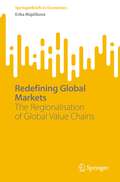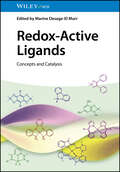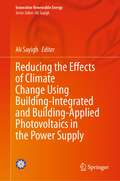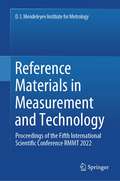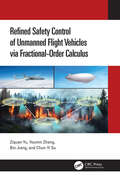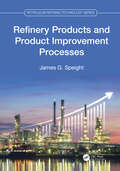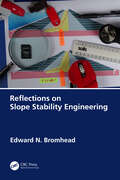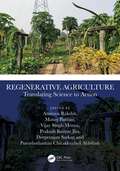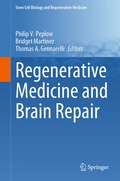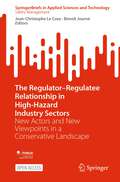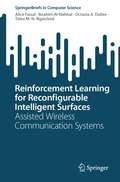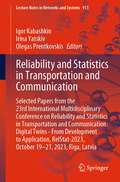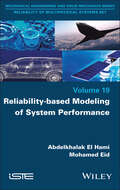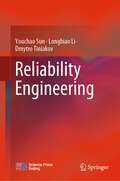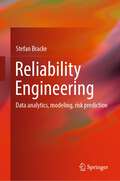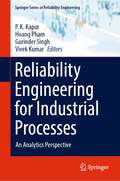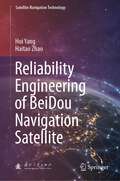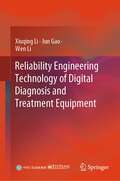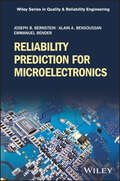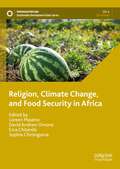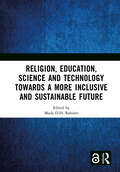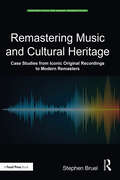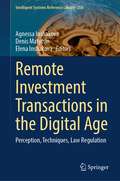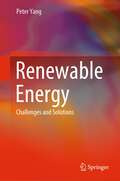- Table View
- List View
Redefining Global Markets: The Regionalisation of Global Value Chains (SpringerBriefs in Economics)
by Erika MajzlíkováThis book analyses the possible regionalization of global value chains, particularly in manufacturing. Amidst calls for an industrial renaissance in Europe and a resurgence of manufacturing jobs in the United States, the dynamics of global value chains have been reshaped by global pandemics, geopolitical tensions, and increased automation. Employing a multi-regional input–output model, the book scrutinizes the decline in offshoring afer the mid-2010s. It sheds light on regionalization as a pivotal force redefining global markets, and focuses on Europe and North America, revealing the strengthening of regional ties. Discussing future challenges, the book will appeal to scholars, students, and researchers, as well as practitioners and policy-makers interested in a better understanding of (de)globalization nuances connected to the evolving role of manufacturing in global value chains.
Redox-Active Ligands: Concepts and Catalysis
by Marine Desage-El MurrRedox-Active Ligands Authoritative resource showcasing a new family of ligands that can lead to better catalysts and promising applications in organic synthesis Redox-Active Ligands gives a comprehensive overview of the unique features of redox-active ligands, describing their structure and synthesis, the characterization of their coordination complexes, and important applications in homogeneous catalysis. The work reflects the diversity of the subject by including ongoing research spanning coordination chemistry, organometallic chemistry, bioinspired catalysis, proton and electron transfer, and the ability of such ligands to interact with early and late transition metals, lanthanides, and actinides. The book is divided into three parts, devoted to introduction and concepts, applications, and case studies. After the introduction on key concepts related to the field, and the different types of ligands and complexes in which ligand-centered redox activity is commonly observed, mechanistic and computational studies are described. The second part focuses on catalytic applications of redox-active complexes, including examples from radical transformations, coordination chemistry and organic synthesis. Finally, case studies of redox-active guanidine ligands, and of lanthanides and actinides are presented. Other specific sample topics covered include: An overview of the electronic features of redox-active ligands, covering their historical perspective and biological backgroundThe versatility and mode of action of redox-active ligands, which sets them apart from more classic and tunable ligands such as phosphines or N-heterocyclic carbenesPreparation and catalytic applications of complexes of stable N-aryl radicals Metal complexes with redox-active ligands in H+/e- transfer transformations By providing up-to-date information on important concepts and applications, Redox-Active Ligands is an essential reading for researchers working in organometallic and coordination chemistry, catalysis, organic synthesis, and (bio)inorganic chemistry, as well as newcomers to the field.
Reducing the Effects of Climate Change Using Building-Integrated and Building-Applied Photovoltaics in the Power Supply (Innovative Renewable Energy)
by Ali SayighThis book looks at the success and continuing potential of photovoltaic (PV) technology in combating climate change by harnessing solar energy through building-integrated (BIPV) and building-applied photovoltaics (BAPV). With PV global capacity soaring from 940 GW in 2021 to 1100 GW in 2022 and projected to reach 1456 GW by the end of 2023, the world is witnessing an unprecedented shift towards renewable energy solutions. Today, no single country exists without some form of PV installation, driven by reduced costs and abundant free sunshine. The book’s chapters delve into the advancements in PV technology, exploring its integration as an essential building material by examining 14 countries and regions – Brazil, The Netherlands, Austria, Poland, Argentina, Iran, Germany, Malaysia, Oman, Bahrain, India, Australia, the United Kingdom, and Egypt – and providing a comprehensive overview of their successful adoption of PV for electricity generation. Whether you’re an architect, builder, engineer, or climate advocate, this vital resource offers insights, international case studies, and a path to a greener future.
Reference Materials in Measurement and Technology: Proceedings of the Fifth International Scientific Conference RMMT 2022
by Egor P. Sobina Sergey V. Medvedevskikh Olga N. Kremleva Ivan S. Filimonov Elena V. Kulyabina Anna V. Kolobova Andrey V. Bulatov Vladimir I. DobrovolskiyThe book covers in particular state-of-the-art scientific research about product quality control and related health and environmental safety topics, including human, animal and plant safety assurance issues. These conference proceedings provide contemporary information on the general theoretical, metrological and practical issues of the production and application of reference materials.Reference materials play an integral role in physical, chemical and related type of measurements, ensuring their uniformity, comparability and the validity of quantitative analysis as well as, as a result, the objectivity of decisions concerning the elimination of technical barriers in commercial and economic, scientific and technical and other spheres of cooperation. The book is intended for researchers and practitioners in the field of chemistry, metrologists, technical physics, as well as for specialists in analytical laboratories, or working for companies and organizations involved in the production, distribution and use of reference materials.
Refined Safety Control of Unmanned Flight Vehicles via Fractional-Order Calculus
by Ziquan Yu Youmin Zhang Bin Jiang Chun-Yi SuThe monograph explores the safety of unmanned flight vehicles via the corresponding fault-tolerant control design methods. The authors analyse the safety control issues of unmanned flight vehicles, which include finite-time recovery against faults, concurrence of actuator faults and sensor faults, concurrence of actuator faults and wind effects, and faults encountered by a portion of unmanned flight vehicles in a distributed communication network. In addition, the commonly used simple but effective proportional-integral-derivative structure is also incorporated into the safety control design for unmanned flight vehicles. By using the fractional-order calculus, the developed safety control results are able to ensure flight safety and achieve the refined performance adjustments against faults and wind effects. The book will be of interest to 3rd/4th year undergraduate students, postgraduate and graduate students, researchers, academic staff, engineers of aircraft and unmanned flight vehicles.
Refinery Products and Product Improvement Processes (Petroleum Refining Technology Series)
by James G. SpeightThis book focuses on the various refinery products, product improvement processes, and solvent processes that are used in the refining industry and the processes used in product improvement to ensure products meet sales specifications. This accessible book is written for engineers, scientists, students, and academics wanting an update on crude oil processing and insight into the direction of the industry.Key features:• Describes the development of technologies for a variety of feedstocks, including heavy feedstocks utilizing advanced pre-treatment processing and hydrotreating.• Presents the initial refining processes and prepares for the new changes and evolution of the industry, including the role of biomass in the future refinery. • Analyses catalyst deactivation mechanism for developing optimum technologies for processing feedstocks with low reactivity.• Includes an extensive glossary which will be beneficial for non-technical readers.
Reflections on Slope Stability Engineering
by Edward N. BromheadSlope stability engineering is both an art and a science practised by many civil and geotechnical engineers involved in work on landslides, earth dams, breakwaters, coastal defence, earthworks slopes for roads, canals, railways, pipelines, housing developments, and other related developments. This book contains the detailed reflections of its author, who has practised and researched in the field for over a half-century. It is written in an informal style that makes it an interesting and thought-provoking practitioner guide to landslides and slope problems and their investigation, analysis, and remediation, considering both natural and man-made slopes and earthworks, and without the need for the usual equations and illustrations. Reflections on Slope Stability Engineering is targeted primarily at practitioners working in the investigations of slope instability and the design and construction of treatments of the problem, especially those early in their careers, but the accessible style also suits students who are developing an interest in the subject and even those engineers with only a casual interest in this branch of geotechnics.
Regenerative Agriculture: Translating Science to Action
by Amitava Rakshit Manoj Parihar Vijay Singh Meena Prakash Kumar Jha Deepranjan Sarkar Purushothaman Chirakkuzhyil AbhilashThis book aims to focus on the current state of knowledge and scientific advances about the complex and intertwined issues of regenerative farming as a transformative solution for offsetting the disastrous climate effects of burning fossil fuels and impairments of natural resource bases. Regenerative agriculture advocates no-till practices, planting cover crops, integrating livestock and crop production, improving animal welfare practices, improving the social and economic well-being of communities, sequestering carbon, improving soil health, and increasing yields and profit with a positive impact on food access or food safety regardless of farm size.This book examines the innovations that will equip agriculture to cope with the competing challenges of addressing food and nutrition security, improving livelihoods, combatting climate change, and sustainably managing natural resources. The scope of this book extends to agricultural scientists, students, consultants, site owners, industrial stakeholders, regulators, and policymakers.
Regenerative Medicine and Brain Repair (Stem Cell Biology and Regenerative Medicine #75)
by Philip V. Peplow Bridget Martinez Thomas A. GennarelliThis book presents the latest knowledge, trends, and advances in cell transplantation and innovations in developing microspheres, 3D biomaterial constructs to enhance transfer, and cell survival to specific regions of the brain. Neurodegenerative diseases and brain injury are increasing. Medications currently only temporarily reduce some of the symptoms but do not cure or delay progression of the disease. Development of effective treatments dramatically improves the independent living and quality of life of patients. Cell transplantation strategies offer an approach to facilitating brain repair, but efficacy is often limited by low in vivo survival rates of cells that are injected in suspension. Transplanting cells that are attached to or encapsulated within a biomaterial construct has the advantage of maintaining cell-cell and cell-material interactions and improving cell survival in vivo. Biomaterials that have been used in preclinical studies to assist with in vivo cell transfer and survival include heparin-chitosan microspheres, poly(lactic-co-glycolic acid) microspheres, RADA 16 microspheres, poly(desaminotyrosyl tyrosine ethyl ester carbonate) microscale scaffolds, carbon nanotubes, collagen-chitosan scaffolds, poly(L-lactic acid) scaffolds, agarose hydrogels, gelatin methacrylate hydrogels, and agarose micro-columns with an extracellular matrix interior. Incorporating growth factors (e.g., glial-derived neurotrophic factor, neurotrophin 3) into the biomaterial constructs increased cell survival and incorporation into the host tissue. International experts in the fields of both experimental and clinical neurological research contribute chapters to this book and discuss the latest achievements in cell transplantation and matrix-assisted cell transfer/survival technologies for diseases such as Alzheimer’s disease, Parkinson’s disease, and brain injuries such as stroke and traumatic brain injury. It is envisaged that research findings in experimental animal models of Alzheimer’s disease, Parkinson’s disease, traumatic brain injury, and stroke promote clinical trials using biomaterial-assisted transfer of cells.
The Regulator–Regulatee Relationship in High-Hazard Industry Sectors: New Actors and New Viewpoints in a Conservative Landscape (SpringerBriefs in Applied Sciences and Technology)
by Jean-Christophe Le Coze Benoît JournéThis open access book addresses relationships that develop from the complex set of legislative, regulatory, and institutional arrangements that arise in the governance of high-hazard industries, especially those connected with safety. It analyses the difference in practices between high-hazard sectors such as nuclear power, chemical processing, and transport with those in the finance and healthcare sectors. The relationship between regulating and regulated entities is important in ensuring that safety is not subordinated to other concerns and in maintaining public confidence. As a result, the brief addresses various pressures and trade-offs inherent in that relationship, trade-offs between such considerations as: cost of the oversight activity and its effectiveness; regulator independence and its level of competency and understanding of the risks involved; ability to provide advice on meeting regulatory goals and being able to criticize decisions made; and effectiveness and intrusion in operational activities. The contributors show how, over time, a more horizontal or “decentred” approach to regulatory oversight has appeared, with a larger degree of delegation of certain decisions to industry and a greater role for a range of third parties such as certification bodies, auditors, insurers, industry associations and NGOs. This book is of interest to academics working in the fields of safety science or organizational management and to practitioners, regulators and policy-makers concerned with health and safety and critical infrastructure.
The Regulatory Landscape in the EU for Dairy Products Derived from Precision Fermentation: An Analysis on the Example of Cheese (SpringerBriefs in Law)
by Federica Ronchetti Laura Springer Kai P. PurnhagenThis book assesses the EU legal framework applicable to dairy products obtained through precision fermentation. It maps the authorisation and labelling requirements for these products to be placed on the EU market. It compares these provisions to those governing the food markets in the USA and Singapore, which are considered to be more innovation-friendly. At the time of writing, the precision-fermented dairy sector is still in the developmental phase, with only a few precision-fermented dairy alternatives available on the market, none of which are present in the EU. Regulatory uncertainty has been cited as significant obstacle for food business operators seeking to introduce alternative protein products in the EU. The book confirms these reports, as the current EU regulatory framework presents several legal uncertainties that are challenging for food business operators to overcome. Broadly speaking, there are two authorisation frameworks applicable to dairy products obtained through precision fermentation in the EU. The choice between these frameworks depends on the presence of genetically modified organisms (GMOs) or residues thereof in the final product. If such GMOs or residues are present, the pre-market authorisation procedure is governed by the Genetically Modified Food and Feed Regulation (GMFR). If the final product does not contain any GMOs or residues, it falls under the scope of the Novel Food Regulation (NFR), and the pre-market authorisation procedure is governed accordingly. Both of these authorisation pathways entail high regulatory requirements, which can pose challenges for the development of the precision fermentation sector. Despite the difficulty in accurately classifying products, it is crucial for food business operators to comprehend the applicable legal framework early in the product development process, given that the authorisation paths differ in their standards. In addition to pre-market authorisation requirements, companies must address labelling issues. Food labelling shall provide a basis for consumers to make informed choices in relation to the foods they consume. The primary objective of EU food labelling law is to prevent consumer deception , making it crucial for dairy products and their animal-free alternatives, to adhere to a stringent naming law as stipulated in the Common Market Organisation and specific accompanying legislation. Moreover, it is imperative to consider regulations regarding the use of health and nutrition claims, as well as labels such as “vegan” or “organic”, etc. Furthermore, the labelling of novel foods and genetically modified foods may necessitate mandatory information specified in the authorisation process. The book serves as a comprehensive guideline for food business operators involved in the production of precision-fermented dairy alternatives, aiding them in navigating the intricate European regulatory landscape.
Reinforcement Learning for Reconfigurable Intelligent Surfaces: Assisted Wireless Communication Systems (SpringerBriefs in Computer Science)
by Alice Faisal Ibrahim Al-Nahhal Octavia A. Dobre Telex M. NgatchedThis book presents the intersection of two dynamic fields: Reinforcement Learning (RL) and RIS- Assisted Wireless Communications. With an emphasis on both discrete and continuous problems, it introduces a comprehensive overview of RL techniques and their applications in the evolving world of RIS-assisted wireless communications. Chapter 1 introduces the fundamentals of RL and deep RL (DRL), providing a solid foundation for understanding subsequent chapters. It also presents the Q-learning, deep Q-learning, and deep deterministic policy gradient algorithms. Chapter 2 provides a holistic overview of RIS-assisted systems and details several use cases in wireless communications. Then, Chapters 3 and 4 present various applications of the discrete and continuous DRL to RIS-assisted wireless communications. From maximizing the sum-rate to minimizing, the system resources and maximizing the energy efficiency. These chapters showcase the versatility of the DRL algorithms in tackling arange of challenges. This book concludes with Chapter 5, which introduces the challenges and future directions in this field. It explores the particulars of hyperparameter tuning, problem design, and complexity analysis, while also highlighting the potential of hybrid DRL, multi-agent DRL, and transfer learning techniques for advancing wireless communication systems. Optimizing RIS-Assisted Wireless Systems requires powerful algorithms to cope with the dynamic propagation environment. DRL is envisioned as one of the key enabling techniques to exploit the full potential of RIS-Assisted Wireless Communication Systems. It empowers these systems to intelligently adapt to dynamic wireless environments, maximize performance metrics, and adjusts their configurations to accommodate diverse use cases efficiently. This book serves as a valuable resource, shedding light on the potential of DRL to optimize RIS-Assisted Wireless Communication, enabling researchers, engineers, advanced level students in computer science and electrical engineering and enthusiasts to grasp the intricacies of this topic. It offers a comprehensive understanding of the principles, applications, and challenges, making it a reference to recognize the full potential of the RIS technology in modern wireless communication systems.
Reliability and Statistics in Transportation and Communication: Selected Papers from the 23rd International Multidisciplinary Conference on Reliability and Statistics in Transportation and Communication: Digital Twins - From Development to Application, RelStat-2023, October 19-21, 2023, Riga, Latvia (Lecture Notes in Networks and Systems #913)
by Igor Kabashkin Irina Yatskiv Olegas PrentkovskisThis book reports on cutting-edge theories and methods for analyzing complex systems, such as transportation and communication networks and discusses multi-disciplinary approaches to dependability problems encountered when dealing with complex systems in practice. The book presents the most relevant findings discussed at the 23rd International Multidisciplinary Conference on Reliability and Statistics in Transportation and Communication (RelStat 2023), which took place as a hybrid event on October 19 – 21, 2023, in/from Riga, Latvia. It spans a broad spectrum of advanced theories and methods, giving a special emphasis to the digitalization of transport systems, as well as smart, artificial intelligence, and digital twins applications.
Reliability-based Modeling of System Performance
by Abdelkhalak El Hami Mohamed EidProbabilistic modeling of system performance, built primarily on the foundation of reliability theory, is referred to as reliability-based modeling. This book progressively builds up the functional complexity of system modeling. It starts by modeling the simplest system that can be designed, and then moves to the functional modeling of the multi-state system, step-by-step. Reliability-based Modeling of System Performance deals with modeling the functioning of systems by presenting its concepts, methods and mathematical tools. It is accessible to engineering students and academics who have already acquired basic knowledge of probability theory, applied statistics, differential calculus, integrals, combinatorial calculus and Boolean algebra.
Reliability Engineering
by Youchao Sun Longbiao Li Dmytro TiniakovThis textbook covers the fundamentals of reliability theory and its application for engineering processes, especially for aircraft units and systems. Reliability basis was explained for the best understanding of reliability analysis application for engineering systems in aviation industry. Several approaches for the reliability analysis and their application with examples are presented. It also introduces main trends in the modern reliability theory development.This book will be interested for university students and early-career engineers of aviation industry majors.
Reliability Engineering: Data analytics, modeling, risk prediction
by Stefan BrackeThis textbook teaches methods of data analytics for technical reliability analyses and risk prognosis on the basis of probabilistics, statistics and modelling. The methods of Reliability Engineering are applied in the elementary phases of the product emergence process (concept and series development, production) as well as during the field use of technical products. This book contains a detailed outline of the basics of statistics, graphical visualisation and calculation methods. Numerous case studies are discussed, representing typical tasks of the engineer in reliability analysis during development/production as well as during the assessment of field damages. The target groups are thus both engineering students and practitioning engineers who deal with technical reliability in the context of the development and manufacturing of complex technical products as well as field data analyses. The presentation of the methods and procedures of Reliability Engineering follows the guideline "theory-guided - practice-oriented", so that this book can be used both as a reference work and as a textbook.
Reliability Engineering for Industrial Processes: An Analytics Perspective (Springer Series in Reliability Engineering)
by P. K. Kapur Hoang Pham Gurinder Singh Vivek KumarThis book explores how transformative changes driven by the new-age economy can bring about improvements in a company's engineering and manufacturing capabilities. The new-age economy is driven by advanced engineering and manufacturing practices, processes, and technologies, including the Internet of Things (IoT), Cloud Computing, Blockchain, Artificial Intelligence, Robotics, Cyber-Physical Systems (CPS), and Internet-enabled systems to automate industrial processes. Today's business dynamics are governed by uncertainties, disruptions, complexities, and ambiguities that demand quicker and more intelligent decisions. These changes could relate a renaissance in the company's engineering and manufacturing capabilities. To sustain these volatile and ever-changing business dynamics, Industry 4.0 and 5.0 have revolutionized how organizations operate and make intelligent business decisions. Moreover, the extensive role of business analytics has overcome the limitations ofclassical computing through new technologies and intelligent computing methodologies. Over the past few years, much emphasis has been given to investing in developing hardware and programming frameworks for achieving computational intelligence using fuzzy logic, evolutionary computation, neural networks, probabilistic methods, and learning theory. Within this frame of reference, the reliability, quality, and maintenance of complex industrial and manufacturing systems are essential for organizations to utilize them successfully for informed decisions. This book focuses on studies that provide new solutions for system reliability, quality, security, and maintainability using quantitative and qualitative research. It emphasizes developments and problems in systems engineering management, systems integration, software and hardware engineering, and the development process.
Reliability Engineering of BeiDou Navigation Satellite (Satellite Navigation Technology)
by Hui Yang Haitao ZhaoThis book describes the reliability research results and experience of BeiDou navigation satellite in engineering development. According to the characteristics of high reliability and high availability, this book discusses the reliability requirements, reliability design, reliability modeling, and reliability analysis of navigation satellite and constellation, focusing on the demonstration and decomposition of reliability requirements, constellation availability design, satellite availability design, and availability analysis. Based on the characteristics of batch production of navigation satellites, the particularity of reliability work is analyzed, and the reliability assurance works during batch production such as process reliability, data consistency comparison, storage reliability, and redundant satellite demonstration are introduced.This book is suitable for spacecraft developers, as well as postgraduates majoring in spacecraft engineering, quality, or reliability.
Reliability Engineering Technology of Digital Diagnosis and Treatment Equipment
by Xiuqing Li Jun Gao Wen LiThis book focuses on the reliability engineering of medical devices, especially digital diagnosis and treatment equipment in China. It details the professional technologies and application methods of reliability design analysis, fault model analysis and reliability test of digital diagnosis and treatment equipment, to meet the needs of project undertakers of digital diagnosis and treatment equipment. From the three aspects: safety analysis and EMC design protection, material selection and control, and software engineering and quality, this book provides professional and technical ideas and methods of reliability for the quality problems prone to occur in the field of medical devices, as well as method guidance for readers. Meanwhile, it runs through the whole process of design, engineering, testing, production and management of all digital diagnosis and treatment equipment research and development enterprises and even product R & D enterprises in the field of medicaldevices. It is used as reading materials for personnel of testing institutions and evaluation institutions in medical devices.
Reliability Prediction for Microelectronics (Quality and Reliability Engineering Series)
by Joseph B. Bernstein Alain Bensoussan Emmanuel BenderRELIABILITY PREDICTION FOR MICROELECTRONICS Wiley Series in Quality & Reliability Engineering REVOLUTIONIZE YOUR APPROACH TO RELIABILITY ASSESSMENT WITH THIS GROUNDBREAKING BOOK Reliability evaluation is a critical aspect of engineering, without which safe performance within desired parameters over the lifespan of machines cannot be guaranteed. With microelectronics in particular, the challenges to evaluating reliability are considerable, and statistical methods for creating microelectronic reliability standards are complex. With nano-scale microelectronic devices increasingly prominent in modern life, it has never been more important to understand the tools available to evaluate reliability. Reliability Prediction for Microelectronics meets this need with a cluster of tools built around principles of reliability physics and the concept of remaining useful life (RUL). It takes as its core subject the ‘physics of failure’, combining a thorough understanding of conventional approaches to reliability evaluation with a keen knowledge of their blind spots. It equips engineers and researchers with the capacity to overcome decades of errant reliability physics and place their work on a sound engineering footing. Reliability Prediction for Microelectronics readers will also find: Focus on the tools required to perform reliability assessments in real operating conditionsDetailed discussion of topics including failure foundation, reliability testing, acceleration factor calculation, and moreNew multi-physics of failure on DSM technologies, including TDDB, EM, HCI, and BTI Reliability Prediction for Microelectronics is ideal for reliability and quality engineers, design engineers, and advanced engineering students looking to understand this crucial area of product design and testing.
Religion, Climate Change, and Food Security in Africa (Sustainable Development Goals Series)
by Loreen Maseno David Andrew Omona Ezra Chitando Sophia ChirongomaThis book addresses the relationship between religion, climate change, and food security in Africa. Contributors to this volume interrogate how and to what extent religion in Africa serves as a resource (or confounding factor) in responding to Sustainable Development Goals 13 (action on climate change) and 2 (achieve Zero Hunger, achieve food security and improved nutrition, and promote sustainable agriculture). Approaching the theme from diverse disciplinary and methodological angles, contributors probe the potential role of religion in Africa to accelerate the achievement of these two SDGs, especially the role of religion with regard to food availability, food accessibility, food utilization, and food systems stability.
Religion, Education, Science and Technology towards a More Inclusive and Sustainable Future: Proceedings of the 5th International Colloquium on Interdisciplinary Islamic Studies (ICIIS 2022), Lombok, Indonesia, 19-20 October 2022
by Rahiem, Maila D.H.This book addresses topics relating to religion, education, science, and technology, and explore their role in developing a more inclusive and sustainable future. With discussions viewed through the lenses of religious and Islamic studies, education, psychology, social science, economics, and natural science, the book is interdisciplinary. It also brings together a range of diverse work by academics around the world including Indonesia, Malaysia, the United States, Australia, Kenya, Germany, and the Philippines. The papers are derived from the 5th International Colloquium on Interdisciplinary Islamic Studies (ICIIS 2022), a prestigious event designed to provide a global forum for academicians, researchers, practitioners, and students to present their research findings to global experts. ICIIS was hosted by (State Islamic University/UIN) of Syarif Hidayatullah Jakarta’s School of Graduate Studies, Indonesia in collaboration with UIN Sultan Thaha Saifuddin Jambi, Indonesia, UIN Mataram Nusa Tenggara Barat, Indonesia and Umma University Kajiado, Kenya.The Open Access version of this book, available at http://www.taylorfrancis.com, has been made available under a Creative Commons [Attribution-Non Commercial-No Derivatives (CC-BY-NC-ND)] 4.0 license.Funded by UIN Syarif Hidayatullah Jakarta.
Remastering Music and Cultural Heritage: Case Studies from Iconic Original Recordings to Modern Remasters (Perspectives on Music Production)
by Stephen BruelRemastering Music and Cultural Heritage presents a detailed account of the culture and practice of remastering music recordings. By investigating the production processes and the social, nostalgic and technological components of remastering practice, the book demonstrates the application of these techniques to iconic recordings by artists including The Beatles, Elton John and Oasis. Through comprehensive interviews with music production professionals directly involved in both the original productions and remastered releases of these iconic recordings – and detailed digital audio analysis – this book offers an extensive insight into music production and remastering practice. Readers learn about the music production techniques behind creating some of the most well-recognised and loved albums of all time, as well as the processes used to create the remasters, to help guide their own projects. Remastering Music and Cultural Heritage is essential reading for students and teachers of music production, professional practitioners and musicians.
Remote Investment Transactions in the Digital Age: Perception, Techniques, Law Regulation (Intelligent Systems Reference Library #250)
by Agnessa Inshakova Denis Matytsin Elena InshakovaThe book contains the results of the best research developments obtained during the implementation of major scientific events organized and carried out with the financial support of the Russian Science Foundation and the President of the Russian Federation.The scientific novelty of the work lies in the fact that for the first time at the level of Russian and international interdisciplinary social and humanitarian sciences, primarily economic and legal, firstly, philosophical concepts and regulatory legal approaches to the regulation of remote investment transactions have been studied; secondly, a set of economic and legal conditions and means of harmonizing and observing the mutual interests of participants in remote investment transactions has been developed and proposed in order to prevent and minimize potential conflicts between the parties; thirdly, the current state and international regulation of investment transactions concluded and executed on Internet platforms was critically assessed; fourthly, a system of guarantees and protection of the rights of participants in remote investment transactions is proposed, including special contractual structures and an economic and legal model for the proper fulfillment of obligations.Measures are substantiated to expand and increase the intensity of the national investment turnover based on the improvement of the current legislation regulating investments through remote digital technologies in the Internet space, which provided a solution to the world scientific problem of great socioeconomic and economic importance. The book is designed for a wide target audience—scientists of different generations, different disciplinary and industry affiliations. Among them are young researchers, as well as scientists who have received recognition from the world scientific community, studying the socioeconomic, managerial, and legal consequences of the emergence and spread of digital technologies in the field of investment. Readers can be all individuals and legal entities interested in the development of digital technologies in the field of investment.
Renewable Energy: Challenges and Solutions
by Peter YangThis book empowers college students and young professionals to develop a critical capacity of climate action in the energy transformation, which is necessary to address unprecedented climate crises. It illuminates the monumental challenges and pioneering solutions in accelerating renewable energy technologies, including solar energy, wind power, bioenergy, hydropower, and geothermal energy, as well as energy storage, along with their practical applications. The book offers the most current insights into innovations in renewable energy and energy storage, which are pivotal in forging a reliable and sustainable future powered exclusively by renewables. Its chapters equip the younger generation with the knowledge and critical skills needed to become well-informed and discerning professionals, ready to meet the demands of future sustainable job markets. Readers are encouraged to actively engage in and contribute to the ongoing revolution in renewable energy and energy storage.
